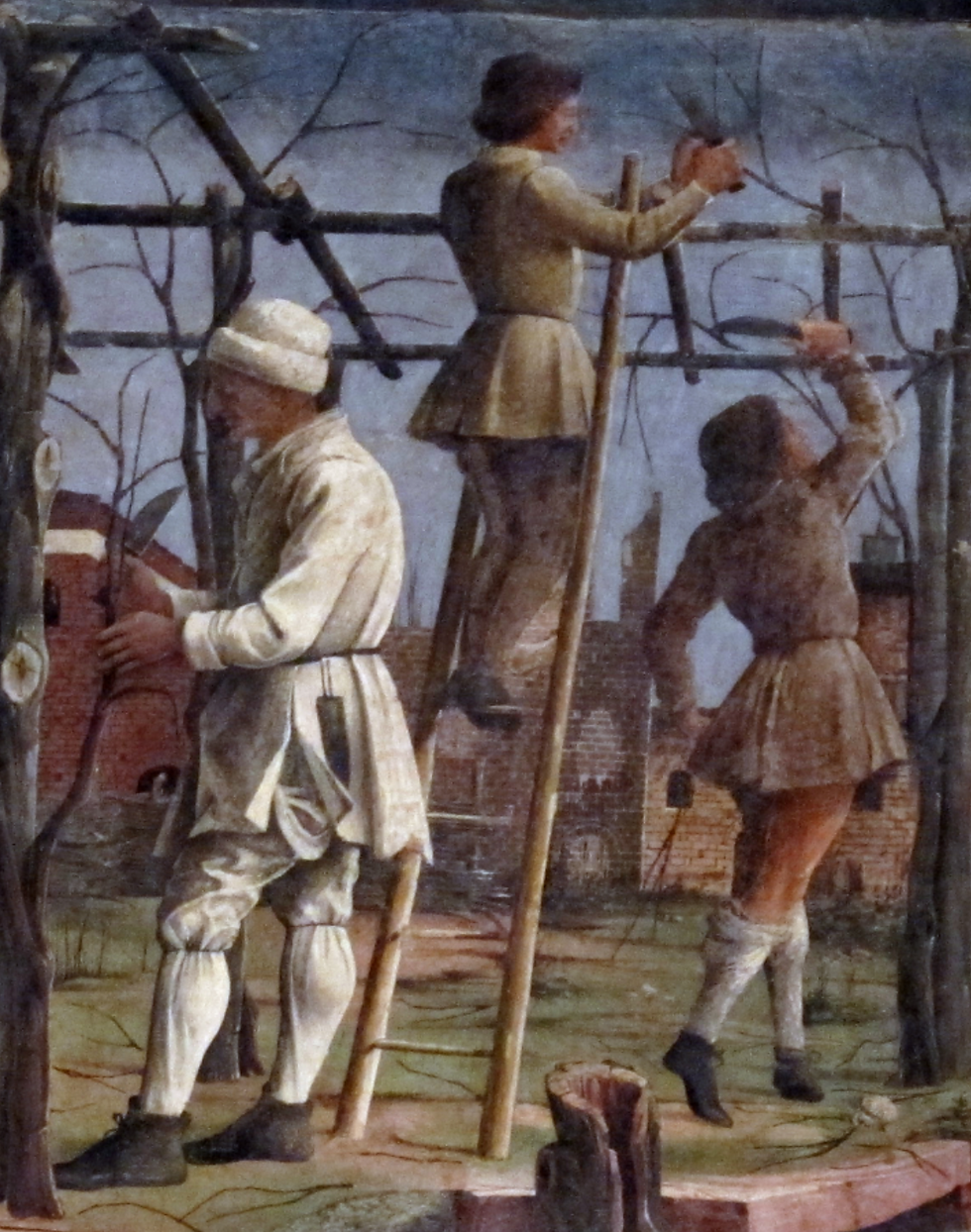Duke of Este donating garments
- ReenactAdvisor
- 5 lug 2022
- Tempo di lettura: 4 min
19 March 1478, Holy Thursday

Duke Ercole I d'Este is in the great hall of his palace, where tables have been set up for a hundred poor Ferrara citizens.
At the Duke's expense they are served "𝑠𝑝𝑙𝑒𝑛𝑑𝑖𝑑𝑖𝑠𝑠𝑖𝑚𝑎𝑚𝑒𝑛𝑡𝑒 𝑑𝑒 𝑝𝑖𝑢̀ 𝑣𝑖𝑣𝑎𝑛𝑑𝑒 𝑒 𝑐𝑜𝑛𝑓𝑒𝑐𝑡𝑖," [wonderfully with many diches and comfits] and 𝑚𝑎𝑥𝑖𝑚𝑒 [most of all] at a table where he had exactly twelve poor citizens seated, among whom he also seated a priest: a clear symbolism to commemorate the table of the apostles!
The courses, however, are not served by the court waiters, but by "𝑙𝑢𝑖 𝑝𝑟𝑜𝑝𝑟𝑖𝑜 [...] 𝑖𝑛𝑠𝑖𝑒𝑚𝑒 𝑐𝑜𝑛 𝑖𝑙 𝑠𝑖𝑔𝑛𝑜𝑟𝑒 𝑚𝑒𝑠𝑠𝑒𝑟 𝑆𝑖𝑔𝑖𝑠𝑚𝑜𝑛𝑑𝑜 𝑒 𝑚𝑒𝑠𝑠𝑒𝑟 𝑅𝑎𝑦𝑛𝑎𝑙𝑑𝑜, 𝑠𝑜𝑖 𝑓𝑟𝑎𝑡𝑒𝑙𝑙𝑖, 𝑒 𝑎𝑙𝑡𝑟𝑖 𝑐𝑎𝑣𝑎𝑙𝑒𝑟𝑖 𝑒 𝑐𝑜𝑚𝑝𝑎𝑔𝑛𝑖" [by - the Duke - himself together with his brothers Sigismondo and Rinaldo, and other knights and companions]: in short, a gesture of great devotion and humility, which culminates in the olther religious ritual of the washing of the feet: "𝑷𝒐𝒊, 𝒕𝒖𝒕𝒊 𝒗𝒆𝒔𝒕𝒊𝒕𝒊 𝒅𝒆 𝒃𝒊𝒂𝒏𝒄𝒉𝒐, 𝒔𝒐𝒂 𝒔𝒊𝒈𝒏𝒐𝒓𝒊𝒂 𝒄𝒐𝒏 𝒍𝒊 𝒂𝒍𝒕𝒓𝒊, 𝒈𝒆̀ 𝒍𝒂𝒗𝒐̀𝒏𝒐 𝒍𝒊 𝒑𝒆𝒅𝒊" [then, all dressed in white, the Duke and the others washed their feet]. It is worth noticing that being dressed in white is both a sign of purity and humility, because colored textiles are more expensive and more aestethically pleasant.
The ceremony is obviously a public demonstration of the Duke's piety, but it is also the assimilation within the court of Ferrara of rituals already performed in other important italian courts, not only Rome but also Naples (and the Aragonese court in Naples was, better to underline it, the only royal court in the Peninsula).
Such a ceremony could not fail to be followed by generous alms, and Bernardino Zambotti, (author of the Ferrarese Diary published in the appendix to Volume XXIV, part 7 of Series II of Rerum Italicarum Scriptores) clearly reports that each poor was given:
𝒖𝒏𝒐 𝒑𝒂𝒓𝒐 𝒅𝒆 𝒔𝒄𝒂𝒓𝒑𝒆 𝒈𝒓𝒐𝒔𝒔𝒆 [one pair of rustic shoes]
𝒖𝒏𝒐 𝒑𝒂𝒓𝒐 𝒅𝒆 𝒄𝒂𝒍𝒛𝒆 𝒕𝒐𝒓𝒄𝒉𝒊𝒏𝒆 [one pair of blu/turquoise]
𝒖𝒏𝒂 𝒃𝒓𝒆𝒕𝒕𝒂 𝒏𝒆𝒈𝒓𝒂 [a black hat]
𝒑𝒂𝒏𝒐 𝒑𝒆𝒓 𝒖𝒏𝒐 𝒗𝒆𝒔𝒕𝒊𝒕𝒐 𝒕𝒐𝒓𝒄𝒉𝒊𝒏𝒐 [cloth for a blu/turquoise overdress]
𝒑𝒂𝒏𝒐 𝒑𝒆𝒓 𝒎𝒂𝒏𝒕𝒆𝒍𝒍𝒐 𝒕𝒐𝒓𝒄𝒉𝒊𝒏𝒐 [cloth for a blu/turquoise cloak]
(the word panno usually means it is a woollen textile)
𝒑𝒊𝒈𝒏𝒐𝒍𝒂𝒕𝒐 𝒑𝒆𝒓 𝒖𝒏𝒐 𝒛𝒊𝒑𝒐𝒏𝒆 [cloth for a doublet]
𝒕𝒆𝒍𝒂 𝒑𝒆𝒓 𝒖𝒏𝒂 𝒄𝒂𝒎𝒊𝒙𝒂 [cloth for a shirt]
𝒎𝒆𝒛𝒐 𝒅𝒖𝒄𝒂𝒕𝒐 [half ducat - the local currency]
Here we find what was considered enough to provide the necessary clothing for a poor person: 1) a pair of shoes "grosse", which meant robust but not elegant, a shirt, the inner garment, close to the skin, to be made in tela (so probably linen as we find in most documents); 2) hoses to cover the legs; remember that hoses at that time were long from foot to hip, tied at the waistline, usually to the doublet, and each one covered one leg. Although it is right in this period that united hoses appear - i.e. similar in shape to our modern trousers - they remained two seaprate elements still for a couple of decades); 3) an overdress (vestito); 4) a woolen cloak; 6) a zipone, which is the farsetto (english doublet) which is worn over the camicia and under the vestito). For the zipone another kind of fabric is provided: it is a strong and decent quality cotton fabric, called pignolato because production processing made the fabric look as if sprinkled with pine nuts.

Note that the poor are not given ready-made clothes, but the fabrics to make them: we are still a long way from pret-a-porter and the standardized measures we are used to nowadays! If we want to visualize the final result, in my opinion this detail of the month of March from the cycle of the months in Palazzo Schifanoia, Ferrara, is very helpful. The frescoes were made between 1468 and 1470, for Borso d'Este, predecessor of Ercole, and in this detail we see people working in a vineyard. Look at thee man who is pruning: he is dressed in white, but is wearing all the items in the list above, including the hat.
Color is not specified for the doublets, and maybe it means that a non-dyed fabric is provided, but the other garments (the ones that can be seen while worn, hoses, overdress and cloak) are all in panno turchino [blue woollen fabric] and that's probably not a coincidence!

In fact, I believe that the color recalls the one of the Este coat of arms, which since the thirteenth century was a white eagle on a blue field (while keeping the original heraldry clearly visible, the coat of arms was enriched during the fifteenth century with other heraldic elements related to the alliances and investitures received over time by memebers of the Este family).
So the Duke was certainly being pious that day (and from that day every Holy Thursday afterwards!), he was giving a demonstration of devotion and humility for himself and for the men of his court who followed his example (because they wanted or because they felt morally forced to emulate the Lord as a good courtier should do? Impossible to know!), but ultimately the ceremony was also a way to show the Ercole's wealth and the growing importance of its Duchy!
So, here's another little piece of information to better know and understand our rich and interesting past!
Comments